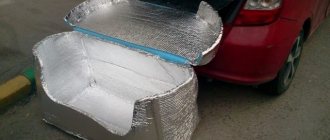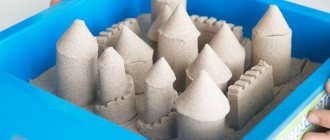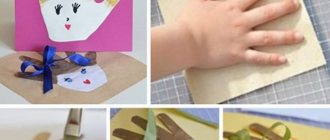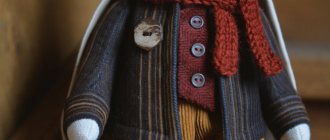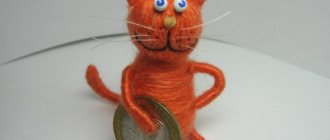A non-Newtonian fluid is a substance whose density directly depends on the velocity gradient. This phenomenon is due to the fact that the liquid consists of large molecules, which, in the absence of external influence, float freely in water (the mixture remains liquid). When a mechanical stimulus appears, the distance between them decreases, and the substance acquires the properties of solids. This behavior of some substances is also closely related to the complex spatial structure of molecules.
You can make a non-Newtonian fluid at home without much effort. It is perfect for playing with children or even performing magic tricks.
What is a non-Newtonian fluid
Before proceeding with direct experiments, I want to literally say in a nutshell what a non-Newtonian fluid is.
So, a non-Newtonian fluid is a fluid in which its own viscosity depends on the velocity gradient. In most cases, such liquids have a highly heterogeneous molecular structure.
We will consider the simplest and therefore most visual experiment, and create a non-Newtonian liquid from ordinary starch and water.
Starch is the main ingredient for preparing a non-Newtonian liquid. Starch is the main ingredient for preparing a non-Newtonian liquid.
And let’s check the postulate, which says: the more rapid the external influence on the macromolecules of the binder suspended in the liquid, the greater the viscosity of the liquid.
Well, now, from the necessary digression, let’s move on to experiments.
Classification and properties
- Dilatant - with increasing shear strain rate, viscosity increases.
- Plastic - under static conditions shows the properties of solid objects. But when you influence it, it shows fluidity.
- Pseudoplastic - when shear stress increases, viscosity, on the contrary, becomes less. A good example is volcanic lava.
Basic properties of non-Newtonian fluid:
- Viscosity and density depend on the impact on it.
- When exposed, it shows the properties of solids.
- The lower the fluid flow rate, the higher the viscosity.
- They have good fluidity and evaporation.
- It is heterogeneous in composition and does not mix well.
- Magnetism has been observed in some species.
How did this concept appear?
Isaac Newton was the first to draw attention to the peculiarities of the viscosity of liquids. He noted that as the speed of fluid flow decreases, its resistance decreases. This data can be easily checked by trying to row the oars quickly and slowly - the latter is definitely easier. Newton's work marked the beginning of the study of the rheological properties of liquids, and at the same time specific mixtures of large molecules were discovered that did not entirely obey generally accepted laws. They were called non-Newtonian and began to be actively studied, but to no avail.
How to make a non-Newtonian fluid at home?
To make a non-Newtonian fluid, you need 200 grams of cornstarch and 400 ml of water. Pour starch into a deep bowl and slowly pour in water, stir. The result is a non-Newtonian fluid. You can experiment endlessly. Here in this video there is a whole pool with this liquid.
What is needed for the experiment
So, in order to create a non-Newtonian fluid you will need:
1. Starch. Absolutely anything you can find in your kitchen or on the shelves of the nearest store will do.
2. Any free container. Personally, I used a large plastic container.
3. Various devices for the experiment. I prepared a hammer and a Soviet meat grinder (you’ll find out what it’s used for in the video). Personally, you can choose whatever your heart desires.
After everything is prepared, you can start preparing the liquid.
We conduct an experiment and prepare a non-Newtonian fluid
To prepare the liquid, pour starch into the prepared container and begin to gradually add water, while not forgetting to mix it all.
Thus, you should get a mixture with a consistency similar to runny sour cream.
You can see the entire cooking process and very exciting experiments in the video below:
As you can see, non-Newtonian fluid is a fascinating and very simple experiment.
To make a non-Newtonian fluid, you need 200 grams of cornstarch and 400 ml of water. Pour starch into a deep bowl and slowly pour in water, stir. The result is a non-Newtonian fluid. You can experiment endlessly. Here in this video there is a whole pool with this liquid.
Rheological models of liquids
Classification is made according to the dependence of viscous stresses on shear rate (velocity gradient) γ˙=|∂v→∂z|{\displaystyle {\dot {\gamma }}=\left|{\frac {\partial {\vec {v} }}{\partial z}}\right|}, where v→{\displaystyle {\vec {v}}} is the flow velocity.
- Newtonian fluid - linear law: σ=αγ˙{\displaystyle \sigma =\alpha {\dot {\gamma }}}
- Power-law fluid is nonlinear, power law: σ=αγ˙n{\displaystyle \sigma =\alpha {\dot {\gamma }}^{n}} Pseudo-plastic — n<1{\displaystyle n<1}, with slow movements viscosity is high and then decreases.
- Dilatant liquid - n>1{\displaystyle n>1}, viscosity increases with increasing speed.
σ={σ+αγ˙,γ˙>−σ+αγ˙,γ˙<{\displaystyle \sigma ={\begin{cases}\sigma _{0}+\alpha {\dot {\gamma }}, {\dot {\gamma }}>0\\-\sigma _{0}+\alpha {\dot {\gamma }},{\dot {\gamma }}<0\end{cases}}}
A clear example of a Bingham fluid is paint - due to the action of binders, a threshold for shear stress arises, and it is capable of forming fixed layers on vertical surfaces. Any other liquids will flow down. For non-Newtonian liquids, it is possible to observe other effects associated with nonlinearity or the existence of a threshold. It is worth noting that the complication of the dependence of viscous stresses forces us to abandon the “traditional” Navier-Stokes equation for a Newtonian fluid by complicating the model of the viscous tensor.
A separate case of non-Newtonian fluids are thixotropic and rheopex fluids, the viscosity of which changes over time.
Another classification is based on the dependence of viscosity η{\displaystyle \eta } on the shear rate γ˙{\displaystyle {\dot {\gamma }}}:
- dηdγ˙>{\displaystyle {\frac {d\eta }{d{\dot {\gamma }}}}>0} corresponds to the case of a dilatant
liquid; - dηdγ˙<{\displaystyle {\frac {d\eta }{d{\dot {\gamma }}}}<0} corresponds to the case of a pseudoplastic
fluid.
Typical examples of dilatant liquids are concentrated suspensions of solid particles (eg quicksand); pseudoplastic - polymer melts and solutions.
Where are non-Newtonian fluids used?
Anomalous substances are used in the following industries:
- In military affairs, the production of body armor with “liquid armor” technology. At the point of impact, the filler instantly hardens. In its normal state, the vest is soft and elastic.
- In automobile production. Special suspensions are added to oils to reduce friction at high engine speeds.
- In the oil industry. Polymer additives are used to reduce the resistance coefficient in pipelines.
- In putting out fires. To increase the length of the jet from the fire nozzle, polymers are mixed into the fire extinguishing solution.
- In the cosmetics industry. Synthetic ingredients, oils, and waxes are added to cosmetics to add viscosity.
The non-Newtonian fluid recipe is used in home cooking. For example, when preparing sauces based on flour, caramel, marmalade.
Classification
There are 3 main groups of anomalous substances.
Viscous
Does not depend on time. Among them there are viscoplastic ones - oil paints, types of paste. Pseudoplastic substances include suspensions of polymers and cellulose. With a little voltage they flow. Dilatant (starch solution, various types of glue) thicken with intense exposure.
Non-rheostable
Subject to the temporary factor. Yogurt, kefir, mayonnaise, and ketchup lose their viscosity when shaken. They are called thixotropic. Rheopectic substances thicken over time. These are colloidal solutions, bentonite clays.
Viscoelastic
Under the influence of force they flow, then restore their previous structure. These include some types of resins and dough-like pastes.
Examples of natural non-Newtonian fluids are quicksand, bogs in a swamp, and ground quicksand.
Cooking features
To create a non-Newtonian liquid at home, you should take cold water, starch (corn or potato - it doesn’t matter), and a deep bowl. Cooking algorithm:
- Pour the starch into a bowl (don't be afraid to add more to get enough of the substance);
- Add water there and slowly stir the mixture;
- Water is added until a mass similar to jelly is obtained;
- It is better to mix with your hands, and you can also add dye to obtain a colored substance;
- Stirring must be continued until a homogeneous mixture is formed.
To make sure you have properly mixed the water with the starch, stir the substance with your hand, gradually speeding up. The liquid will begin to solidify, and you will feel the resistance increase as the mixing force increases. As soon as the hand stops, the mixture will again become a regular liquid. After this, you can show the trick to the child and play with him.
A non-Newtonian liquid can be made with PVA glue and borax, but then you need to be careful so that children don’t put the interesting thing in their mouth.
To do this, you will need two glasses of water (one half filled, the other three-quarters full), a glass of glue and a tablespoon of borax.
Glue is added to a fuller glass, and borax to a half-filled glass. Both mixtures are thoroughly stirred and combined in one container. It is better to keep such a substance in the refrigerator, because it is not very convenient to prepare it again every time.
Can it be used somewhere?
Despite such interesting properties, non-Newtonian liquid has not found its practical application. Its characteristics are so unstable and difficult to predict that even in the age of technological development it is only suitable for playing with children.
The huge advantage of the liquid is its complete safety, so parents can play even with infants. If it occurs to the baby to try an unusual substance, then there will be no harm from it. The exception is colored liquids, but if you use food coloring, you can safely leave the child alone with such an interesting game. The only thing: don’t be surprised if, upon your return, you find your child, kitchen, and even a cat passing by dirty.
Experiments
Both for the purpose of scientific knowledge and just for fun, you can try the following experiments:
- Run your finger over the surface of the resulting clot. Did you notice anything?
- Dip your entire hand into the mysterious substance and try to squeeze it with your fingers and pull it out of the container.
- Try rolling the substance in your palms to form a ball.
- You can even slap the clot with your palm as hard as you can. The spectators present will probably run away, expecting that they will now be sprayed with a starch solution, but the unusual substance will remain in the container. (Unless, of course, you spared starch.)
- Video bloggers offer a spectacular experiment. For it you will need a music speaker, which should be carefully covered with thick cling film in several layers. Pour the solution onto the film and play music at high volume. You will be able to observe stunning visual effects that are only possible with this unique composition.
If you are performing an experiment in the laboratory in front of schoolchildren or students, ask them why a non-Newtonian fluid behaves the way it does.
Why does it feel like a solid when you squeeze it in your hand, but flow like syrup when you open your fingers? Once the discussion is over, you can place the clot in a large plastic zip-lock bag to store it for next time. It will be useful to you to demonstrate the properties of the suspension.
Curious experiments
- You can roll the ball, and then relax your fingers and watch the ball begin to flow through them.
- Place any object in the liquid, maybe your hands, or for example a cup, and then sharply pull it out and the object will lift the container into the air along with the contents. Your hands will simply be cemented there.
- It is very interesting to watch how liquid flows from one saucer to another and hardens.
- You can tap the liquid and observe that the liquid behaves like a solid object.
Newtonian liquid as a toy is also notable for the fact that it is completely safe (unlike Chinese slimes). If a child even tries it (although I don’t think he’ll like it), it definitely won’t do him any harm. But after the game, the room, table, chair and bathtub are literally smeared with white spots which, by the way, are very easily washed off, just like a child’s hands!
Common flubber
Pour 3/4 cup of water and one cup of PVA glue into a separate bowl, mix these ingredients thoroughly and proceed to the next step.
In another bowl, you need to mix half a glass of water and 2 tablespoons of borax. Stir until the borax dissolves. Then combine the two resulting solutions and mix.
You can add coloring. After this, you need to place the resulting Newtonian fluid in a bag, close it and knead it. The resulting substance can be stored in this form.
Smart plasticine
For this method you will need the following components: PVA glue, sodium tetrabarate, food coloring.
Take a bowl, pour glue (about 100 grams), add dye and mix. Next, you need to add sodium tetrabarate and mix until a dense mass is formed.
Edible Newtonian fluid
Take a saucepan, pour in the condensed milk, put it on low heat, add a spoonful of starch, continuing to stir slowly. Once the liquid has thickened, you can add food coloring and stir everything again. Leave the resulting liquid on the window to cool. Be careful as Newtonian fluid can stain clothing and other items.
Well, today I want to tell you about a non-Newtonian fluid, which we finally made with our son, when once again we had to sit at home, recover and look for something to do with this restless creature. I heard and read a lot about this interesting substance, but for some reason I was afraid to do it, it seemed to me that it was very difficult.
It turns out that making a non-Newtonian liquid with your own hands is very simple, and preparing it will not be difficult at home.
Why is it called that? I think it’s better to ask physicists, since this is still more of a physical experiment than a chemical one, but I would venture to suggest that it’s all about the properties. An ordinary liquid, subject to the classical laws of physics formulated by Newton, behaves as we are accustomed to.
Imagine water. It flows, you can pour it from vessel to vessel, you can stamp your foot on it, raising clouds of splashes, you can splash it, splash it in all directions - and it will remain unchanged in its physical properties, it will always be liquid, flowing. There are many such examples - milk, gasoline, acetone, etc.
What is a non-Newtonian fluid? This is a substance that behaves completely unexpectedly when a force is applied to it. For example, in a calm state it is a pliable, flowing substance that can be spilled on the table, forming an ordinary unremarkable puddle.
But if you want to hit this puddle with your fist or, better yet, with a hammer, you will encounter unexpected resistance - the soft puddle will suddenly become hard and may even shatter into fragments. That is, it turns into a solid body.
The properties of such a solution are related to viscosity, or more precisely, to its change under external influence. As long as you do not apply any force to this solution or try to subject it to any deformation, you will have an obedient liquid in your hands.
As soon as you applied force, that is, changed the external influence, the viscosity instantly changed. Moreover, the higher the speed, that is, the faster you apply the external force, the more the viscosity will change.
The most common example of such a substance is starch mixed with water. How to make this interesting liquid from it yourself? To be honest, I didn’t follow the recipes and proportions that I came across. Everything was done “by eye,” but it turned out so interesting that my son and I spent almost the entire evening in the kitchen, playing with the resulting substance, making up the table, walls, floor, and even a little of the ceiling. But it was worth it. Both had more than enough joy!
I bought corn starch by weight at the market. I can’t even say who made it, since it was an ordinary plastic bag without any identification marks. 1 kg costs 380 tenge, which is approximately 70 Russian rubles.
I poured it into a bowl and began to gradually add water, stirring immediately. At some stage I felt that the spoon was beginning to turn with difficulty in this kind of “dough”, as if in hardening cement.
I put the spoon aside and started trying it with my hands - if you slowly immerse your hand in the solution, it calmly sinks to the bottom of the plate. If you sharply hit the surface of the solution with your palm, it seems as if you are knocking on something hard, but your hand remains dry and clean.
They say that instead of corn starch, you can use potato starch. I fully admit it, but I can’t say anything from my experience, since I only tried it on corn. I think that this does not matter, since, in essence, the composition is the same; in any case, the result is a solution of a polymer (starch is a natural polymer), that is, large molecules that are connected to each other in a variety of positions, which determines such interesting properties of the resulting solution.
So we spent the whole evening doing a variety of experiments with our son. Very interesting tactile sensations, no less funny than with the same hydrogel.
They dipped their hands, spoons, and forks into the solution. They hit the solution sharply and poured it slowly and quickly. If you put your hand under the stream while pouring, the flowing stream instantly hardens, hitting your fingers.
Then I remembered that I once saved an article about how to make homemade kinetic sand, it also needed cornstarch. Why not give it a try, since you've already started pigging out in the kitchen? I just had clean, sifted sand, which I once prepared for experiments with “chemical snakes.”
All you need to do is mix sand, starch and water. They mixed it - it turned out to be garbage. Not kinetic sand at all, but an amazingly convenient version of a non-Newtonian liquid that does not dirty your hands and, nevertheless, does not lose its unusual properties.
You can mix it, pour it, roll it into balls, throw it forcefully on the table, hit it with your hands. For example, you can roll it into a sausage - while you roll it in your hands, it is hard, but as soon as you stop rolling it, it immediately turns into a puddle right in the palm of your hand.
Types of non-Newtonian behavior
Summary
Classification of fluids with shear stress as a function of shear rate.
Comparison of non-Newtonian, Newtonian and viscoelastic properties
| Viscoelastic | Kelvin material, Maxwell material | “Parallel” linear combination of elastic and viscous influences. | Some lube, whipped cream, Silly Putty |
| Time dependent viscosity | Reopections | Apparent viscosity increases with increasing load duration | Synovial fluid, printer ink, gypsum paste |
| Thixotropic | Apparent viscosity decreases with increasing loading duration. | Yogurt, peanut butter, xanthan gum solutions, aqueous iron oxide gels, gelatin gels, pectin gels, hydrogenated castor oil, some clays (including bentonite and montmorillonite), suspension of carbon black in molten tire rubber, some drilling fluids, many paints, many flake suspensions , many colloidal suspensions | |
| Non-Newtonian viscosity | Shear thickening (dilatant) | Apparent viscosity increases with increasing load | Suspensions of corn starch in water (oobleck) |
| Shear thinning (pseudoplastic) | Apparent viscosity decreases with increasing load | Nail polish, whipped cream, ketchup, molasses, syrups, paper pulp in water, latex paint, ice, blood, some silicone oils, some silicone coatings, sand in water | |
| Generalized Newtonian fluids | Viscosity is constant. The stress depends on the normal and shear strain rates and the pressure applied to it. | Blood plasma, custard, water |
Popular articles Women's mittens with a Norwegian star
Shear thickener
The viscosity of a shear thickening fluid or dilatant fluid appears to increase with increasing shear rate. Cornstarch suspended in water (“oobleck”, see) is a typical example: when stirred slowly it appears milky white, but when stirred vigorously it appears as a very viscous liquid.
Shear thinner
Paint is a non-Newtonian fluid. A flat surface covered with white paint is oriented vertically (before filming, the flat surface was horizontal and placed on a table). The fluid begins to flow over the surface, but due to its non-Newtonian nature, is subject to stress due to gravitational acceleration. So instead of sliding across the surface, it forms a very large and very dense droplet with limited flow.
A familiar example of the opposite - shear thinner or pseudoplastic fluid - is wall paint: the paint should flow easily from the brush when applied to the surface, but not drip excessively
Note that all thixotropic fluids are highly shear thinning, but they are highly time dependent, whereas colloidal "shear thinning" fluids respond instantaneously to changes in shear rate. Thus, to avoid confusion, the latter classification is more clearly called pseudoplastic.
Another example of a shear thinning fluid is blood. This application is very popular in the body because it allows blood viscosity to decrease with increasing shear rate.
Bingham plastic
Fluids that have a linear shear stress/shear strain relationship require a finite yield stress before they begin to flow (the shear stress vs. shear strain graph does not pass through the origin). These liquids are called Bingham plastics. A few examples are clay slurries, drilling mud, toothpaste, mayonnaise, chocolate and mustard. There may be ridges on the surface of the Bingham plastic when it is stationary. In contrast, Newtonian fluids at rest have flat, featureless surfaces.
Rheopectic or antithixotropic
There are also liquids whose rate of deformation depends on time. Fluids that require a gradual increase in shear stress to maintain a constant strain rate are called rheopectic. The opposite case is a fluid that thins over time and requires a reduction in stress to maintain a constant strain rate (thixotropic).
How to play with non-Newtonian fluid?
- You can crush it in your hands, noting how it suddenly becomes hard but flexible; sculpt figures that immediately spread into a puddle. An interesting effect is obtained if you try to pour a non-Newtonian liquid from cup to cup: it flows in an even stream, but as soon as you shake the container, the liquid solidifies, as if on the command “freeze!”
- A non-Newtonian fluid reacts not only to mechanical stress, but also, for example, to sound waves; if you have a powerful enough speaker, it will "dance" to the music. If you slowly add food coloring to it, the effect will be unforgettable!
- Finally, if you don’t mind the starch, you can fill the bathtub with a non-Newtonian liquid - not to the top, of course, only about 10 centimeters. Children like to jump on a hard surface and, when they stop, “drown” in it!
Sources
- https://zen.yandex.ru/media/energofiksik/neniutonovskaia-jidkost-i-interesnye-opyty-s-nei-5e6e1e865f50cb6af854d1b8
- https://dishlab.ru/blog/kak-sdelat-nenyutonovskuyu-zhidkost-i-idei-dlya-igr-s-ney/
- https://zen.yandex.ru/media/sntch/neniutonovskaia-jidkost-chto-eto-i-kak-sdelat-svoimi-rukami-5b6ab6d8505f6500a95d7f19
- https://ideikin.ru/nyutonovskaya-zhidkost-kak-sdelat/
- https://OkLenta.ru/podelki/nenyutonovskaya-zhidkost-svoimi-rukami-2.html
- https://sibmama.ru/opit_exeriment_5.htm
[collapse]
Experiments for young children
Perhaps not a single science show for children today can do without a non-Newtonian fluid: simple and effective experiments do not require large expenses, and any mother can implement them. All you need is water and starch!
Once, at such a scientific show in the fresh air, I even had a chance to observe a shallow long hole filled with a “magic” starch mixture: when a child stood in it, he plunged into the liquid, and when he ran, it miraculously turned into a solid surface under his feet. Well, if you accelerate properly!
“Preparing a non-Newtonian liquid at home is very simple: to do this, you need to mix starch with warm water, and it is not necessary to maintain exact proportions. Both 1:1 suspensions and 2 parts starch to one part water work equally well, so dilute the starch without getting nervous or worrying about over- or under-watering.
experimental part
In the practical part, we conducted several experiments.
Experiment No. 1 “Obtaining a non-Newtonian liquid”
Goal: to obtain a non-Newtonian fluid and check how it behaves under normal conditions.
Equipment: water, starch, bowl.
Progress of the experiment:
- They took a bowl of water and starch. Mixed equal parts of the substance.
- The result was a white liquid.
We noticed that if you stir quickly, you feel resistance, but if you stir more slowly, you don’t. You can pour the resulting liquid into your hand and try to roll it into a ball. When we act on the liquid, while we roll the ball, there will be a solid ball of liquid in our hands, and the faster and stronger we act on it, the denser and harder our ball will be. As soon as we unclench our hands, the hitherto hard ball will immediately spread over our hand. This will be due to the fact that after the influence on it ceases, the liquid will again take on the properties of the liquid phase.
Experiment No. 2 “Study of some physical properties of non-Newtonian liquids”
To study the properties, we took a mixture of starch and water obtained in the previous experiment, shower gel and sunflower oil.
The purpose of this experiment: to experimentally determine the density, boiling point and crystallization temperature of these liquids.
As a result of the experiments, we obtained the following data:
Experiment No. 3 “Studying the influence of magnetic fields on a non-Newtonian fluid”
Experiments with ferrofluid are widely distributed in the form of videos on the Internet. The fact is that this type of liquid, under the influence of a magnet, makes certain movements, which makes the experiments very spectacular.
Ferromagnetic fluid can be made with your own hands at home. To do this, we’ll take oil (motor oil, sunflower oil, etc. are suitable), as well as toner for a laser printer (a substance in powder form). Now mix both ingredients to the consistency of sour cream.
In order for the effect to be maximum, heat the resulting mixture in a water bath for about half an hour, not forgetting to stir it. Ferromagnetic liquid (ferrofluid) is a liquid that is highly polarized under the influence of a magnetic field. Simply put, if you bring an ordinary magnet closer to this liquid, it produces certain movements, for example, it becomes like a hedgehog, stands up with a hump, etc.
Making a toy - slime
The very first slime toy was made by Mattel in 1976. The Slime toy has earned popularity due to its amusing properties - both fluidity, elasticity and the ability to constantly transform. Possessing the properties of a non-Newtonian fluid, the slime toy quickly became incredibly popular with children and adults. Slime could not be bought everywhere, but they soon learned how to make a funny toy at home.
Making slime with your own hands and at home differs from the original recipe. Therefore, we will use more accessible substances:
- PVA glue. White, preferably fresh, glue can be purchased at any office supply or hardware store. We will need about half a regular glass of glue for Lizun, about 100 grams.
- Water is the most common tap water. If desired, you can take boiled, at room temperature. You will need a little more glass.
- Sodium tetraborate, borax or borax. Can be purchased at a pharmacy in the form of a 4% solution.
- Food coloring or a few drops of brilliant green. The original slime is green, and brilliant green is perfect as a coloring agent.
- Measuring cup, utensils and mixing stick. As a stick, you can take a pencil, spoon or any other suitable object.
Applications of Newtonian fluids
Oddly enough, these liquids are very popular in the world. When studying non-Newtonian fluids, their viscosity is first studied. Knowledge about viscosity and how to measure and maintain it helps in medicine, technology, cooking, and cosmetics production.
Application in cosmetology
Cosmetic companies make huge profits by finding the perfect balance of viscosity that customers love.
To ensure that cosmetics stick to the skin, they are made viscous, whether it is liquid foundation, lip gloss, eyeliner, mascara, lotions, or nail polish. The viscosity for each product is selected individually, depending on the purpose for which it is intended. Lip gloss, for example, should be viscous enough to stay on the lips for a long time, but not too viscous, otherwise those who use it will feel unpleasantly sticky on the lips. In the mass production of cosmetics, special substances called viscosity modifiers are used. In home cosmetics, various oils and wax are used for the same purposes.
